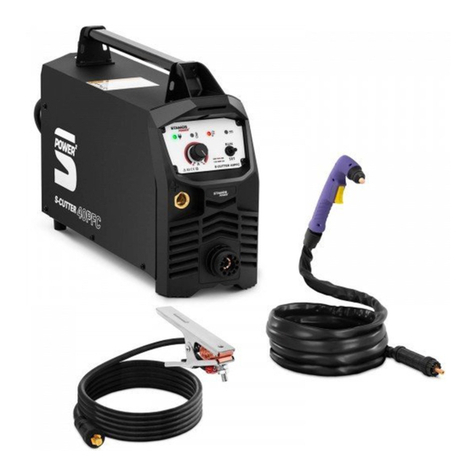
4 5
Rev. 03.02.2017 Rev. 03.02.2017
• Es sollte insbesondere darauf geachtet werden, dass Funken oder heiße Metallspritzer beim Schneiden
nicht durch Schlitze oder Öffnungen im Gehäuse, oder durch den Schutzschirm gelangen können.
• Achten Sie aufmerksam auf Feuer und statten Sie Ihren Arbeitsplatz mit einem Feuerlöscher aus.
• Achten Sie darauf, dass das Schneiden auf der einen Seite ein Feuer auf der gegenüberliegenden, nicht
sichtbaren Seite verursachen kann.
BEARBEITEN SIE KEINE GESCHLOSSENEN BEHÄLTER WIE Z.B. TANKS ODER
FÄSSER.
Das Stromkabel ist an die, am nächsten gelegene Steckdose anzuschließen. Vermeiden Sie eine fahrlässige
Kabelverteilung im Raum und auf nicht kontrollierten Oberächen, da dem Benutzer ein Stromschlag oder
ein Brand drohen kann.
• Benutzen Sie den Plasmaschneider nicht um gefrorene Rohre aufzutauen.
• Es darf nicht an Behältern oder Fässern geschnitten werden, die leichtbrennbare Substanzen enthalten
oder enthielten. Diese müssen vorher geleert und ausgiebig gesäubert werden.
• Schneiden Sie nicht wenn sich in der Luft entammbare Partikel oder Dämpfe benden.
• Schneiden Sie nicht an unter Druck stehenden Zylindern, Leitungen oder Gefäßen.
• Beim Schneiden ist eine saubere, feuerfeste und nicht leitende Schutzkleidung (Leder, dicke Baumwolle)
ohne Ölspuren, Lederhandschuhe, feste Schuhe und eine Schutzhaube zu tragen.
• Vor dem Beginn der Arbeit sind alle leicht brennbaren oder explosiven Gegenstände oder Materialien,
wie Propan-Butan, Feuerzeuge oder Streichhölzer außer Reichweite zu bringen.
• Die Sicherheits- und Arbeitsschutzvorschriften für das Plasmaschneiden sind zu befolgen. Die
Arbeitsstelle muss mit einem geeigneten Feuerlöscher ausgerüstet werden.
• Ein Kontakt mit den elektrisch geladenen Teilen kann zu einem Stromschlag oder zu einer ernsthaften
Verbrennung führen. Die Fackel und der Arbeitskreislauf sind elektrisch geladen, sobald der Strom
eingeschaltet ist. Der Eingangsstromkreis und der innere Stromkreislauf der Maschine stehen auch
unter Strom sobald der Strom eingeschaltet ist.
ELEKTRISCHER SCHOCK IST LEBENSGEFÄHRLICH
• Vermeiden Sie unbedingt den Kontakt mit geladenen elektrischen Teilen.
• Verwenden Sie trockene und unbeschädigte Handschuhe, sowie passende Schutzkleidung.
• Es sind Isolierungsmatten oder sonstige Isolierungsbeschichtungen auf dem Boden zu verwenden. Diese
müssen ausreichend groß sein, sodass der Kontakt des Körpers mit dem Gegenstand oder mit dem
Boden nicht möglich ist.
• Berühren Sie keine Teile der Fackel, wenn diese gerade in Kontakt mit dem Gegenstand oder dem
Boden ist.
• Vor der Reinigung oder dem Austausch der Elektrode ist die Stromversorgung abzuschalten.
• Schalten Sie den Eingangsstrom ab bevor Sie das Gerät installieren.
• Überprüfen Sie, ob das Erdungskabel, sowie der Stecker richtig an die geerdete Steckdose angeschlossen
wurde. Der fehlerhafte Anschluss der Geräterdung kann zur Gefahr für Leben und Gesundheit werden.
• Verizieren Sie immer den Erdungsanschluss.
• Bevor Sie die Eingangsverbindung vornehmen, fügen Sie erst einen geeigneten Erdleiter hinzu.
• Überprüfen Sie die Stromkabel regelmäßig auf Beschädigungen oder mangelnde Isolierung. Beschädigte
Kabel sind auszutauschen. Eine fahrlässige Reparatur der Isolierung kann zum Tod oder zu erheblichen
Gesundheitsproblemen führen.
• Schalten Sie das Gerät ab, wenn es nicht in Gebrauch ist.
• Überprüfen Sie die Kabel und ersetzen Sie diese umgehend, wenn Sie zu starke Gebrauchsspuren
aufweisen oder beschädigt sind.
• Wickeln Sie das Gerätekabel nicht um Ihren Körper.
• Erden Sie den Arbeitsgegenstand an einen guten elektrischen Erdungsuntergrund.
• Nutzen Sie bitte nur gut erhaltene Ausstattung.
• Reparieren oder ersetzen Sie umgehend beschädigte Bestandteile des Gerätes.
• Tragen Sie ein Sicherheitsgurt wenn Sie in Höhen arbeiten.
• Bewahren Sie alle Teile und Abdeckungen an einem Ort auf.
• Bei der Einschaltung ist die Pistolenspitze und der Führungsbogen möglichst weit vom Körper zu halten.
• Befestigen Sie das Arbeitskabel an einem guten metallischen Kontakt des Arbeitsgegenstandes (kein
Stück, das abfallen könnte) oder an dem Arbeitstisch so nah am Schneidegerät, wie es zweckmäßig
erscheint.
DE DE
• Isolieren Sie die Arbeitsklammer wenn Sie nicht mit dem Arbeitsgegenstand verbunden ist um Kontakt
mit jeglichem Metall zu vermeiden.
Es besteht eine SIGNIFIKANTE GLEICHSPANNUNG nach dem Entfernen des
Stromkabels aus der Stromquelle.
Schalten Sie das Gerät aus, trennen Sie das Stromkabel, überprüfen Sie die Spannung auf dem
Eingangskondensator und versichern Sie sich, dass die Spannung nahe dem Nullpunkt liegt, bevor Sie Teile des
Gerätes berühren. Überprüfen Sie die Kondensatoren hinsichtlich der Angaben, die im Kapitel Wartung der
Bedienungsanleitung beschrieben werden, bevor Sie irgendwelche Teile des Gerätes berühren.
ELEKTRISCHER SCHOCK KANN TÖDLICH SEIN.
Am Stromrichter können nicht betriebssichere Teile explodieren, sobald diese mit Strom versorgt werden.
Tragen Sie immer einen Gesichtsschutz und Schutzkleidung, wenn Sie den Stromrichter bedienen.
EXPLODIERENDE TEILE KÖNNEN VERLETZUNGEN VERURSACHEN.
Funken und Metall spritzen vom Schweißblatt ab.
FLIEGENDE FUNKEN KÖNNEN VERLETZUNGEN VERURSACHEN.
• Tragen Sie einen Gesichtsschutz oder Sicherheitsbrille mit Seitenabdeckung.
• Tragen Sie geeigneten Körperschutz um die Haut zu schützen.
• Tragen Sie feuerfeste Ohrstöpsel oder einen anderen Gehörschutz, um zu verhindern das Funken in
die Ohren gelangen.
• Die Bogenstrahlen vom Schneidvorgang produzieren immense sichtbare und unsichtbare (ultraviolette
und infrarote) Strahlen, welche die Augen und die Haut verbrennen können.
BOGENSTRAHLEN KÖNNEN AUGEN UND HAUT VERBRENNEN!
• Verwenden Sie einen Gesichtsschutz (Helm oder Haube) und einen Augenschutz mit einem
entsprechenden Verdunklungslter, der für Sehvermögen des Schweißers und für den Schweißstromwert
geeignet ist.
• Die Sicherheitsstandards geben den Farbton Nr. 9 (min. Nr. 8) für jede Stromstärke unter 300 A vor.
Niedrigere Werte dürfen verwendet werden, wenn der Bogen den bearbeiteten Gegenstand überdeckt.
• Verwenden Sie immer eine Schutzbrille mit Seitenschutz und entsprechender Zulassung bzw. eine
andere Schutzabdeckung.
• Verwenden Sie Schutzabdeckungen an der Arbeitsstelle, um andere Personen vor dem blendenden
Licht oder Spritzern zu schützen.
• Unbeteiligte Personen sind bezüglich der Gefahren durch das Schauen auf den elektrischen Bogen zu
warnen.
WÄRMESCHUTZ
Der Wärmeschutzkreislauf setzt sich in Gang, wenn das Gerät die Einschaltdauer überschreitet. Er bewirkt,
dass das Gerät seine Funktion einstellt.
DUTY CYCLE
Die Einschaltdauer ist der Prozentsatz der Betriebsdauer (gemessen in Minuten) einer 10-minütigen
Zeitperiode in der die Maschine ununterbrochen bei üblichen Temperaturbedingungen genutzt wird.
Wenn Sie die Einschaltdauer-Werte überschreiten, wird dieses den Überhitzungsschutz auslösen, der das
Gerät bis es auf die normale Arbeitstemperatur herabgekühlt ist, zum Stoppen bringt. Ununterbrochenes
Überschreiten der Einschaltdauer-Werte kann das Gerät enorm beschädigen.






























